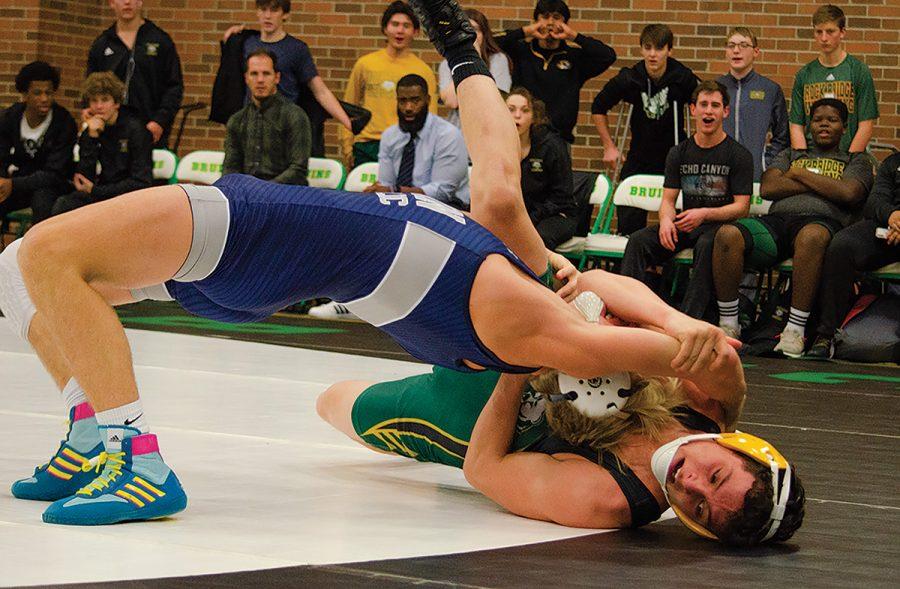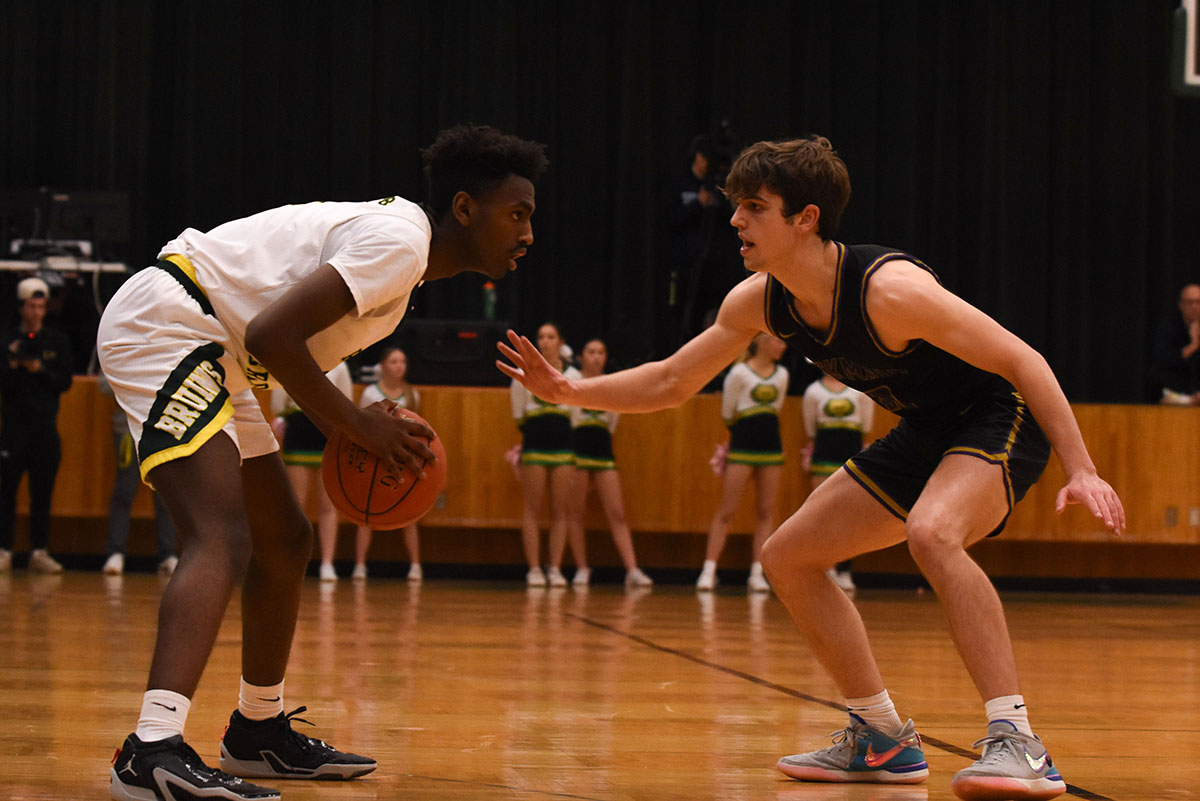In wrestling, making a weight can be the difference between facing a physically larger and more imposing opponent or being that opponent.
The Missouri State High School Activities Association (MSHSAA) follows specific rules and regulations for wrestling from the National Federation of State High School Associations, where male competitors compete in 14 weight classes ranging from 106 pounds to 285 pounds — female wrestlers follow a similar set of rules but use different weight classes. Throughout the season, wrestlers weigh themselves each day and use it to update which weight class they will compete in at a tournament.
Junior Garrett Roach began wrestling in his freshman year after encouragement from a cousin. Roach said the part he enjoys most is “the confidence” that wrestling gives him, along with “the team culture and chemistry.” Roach said one common strategy in wrestling he learned is to be the heaviest competitor in a weight class without exceeding the maximum weight. Roach, who wrestles in the 132-pound and 138-pound classes, said being the heaviest wrestler in a class can give a bulk advantage over the rest of the competitors.
“I was about five pounds over, and I was wrestling the next day, so I put on two pairs of sweats and two sweatshirts, and I taped the sleeves and ankles so the heat would stay in,” Roach said. “[Our team] went outside to the stadiums, and I had to run up and down the stairs and around the track. After a while, the sweat builds up in the clothes, and your body stops wanting to sweat, so I took off the outfit and put another dry one on to sweat more.”
This tactic seemed fairly successful, as Roach said he lost about four pounds in just 90 minutes. Workout alone, however, cannot help a wrestler consistently lose or gain weight. A rigid regiment that is mindful of calorie intake per day is also crucial.
First-year head boys’ and girls’ wrestling coach Robin Watkins, a former high school wrestler from Baltimore, brings a new mindset to the team. Over the past two years, former head coach Eric Wilson encouraged RBHS wrestlers to lose weight. Watkins said he personally prefers for wrestlers to gain weight but ultimately said cutting or losing weight is more of a mental obstacle than a physical one.“Most times when somebody is cutting a lot of weight, they’re ducking somebody [and] avoiding competition. You can starve yourself down, but that doesn’t really mean you’re going to be any better,” Watkins said. “To me, the weight process is more psychological. Your technique, your ability, transcends weight.”
Watkins said the “emphasis shouldn’t be on cutting weight; if anything it should be [on] getting stronger and [improving] technique.” He pointed to freshman Carter McCallister, who is ranked 15th in the nation for the 106-pound class, according to preseason rankings from WIN magazine, and sophomore Anna Stephens as “great examples” of wrestlers whose technique, talent and skill transcend weight classes.
Stephens, who competes in the 130-pound weight class, started wrestling in the seventh grade after watching old tapes of her father, who is a former RBHS wrestler. The company of her teammates, love of competition and desire to improve her skill motivated Stephens to join the RBHS wrestling team. Two years later, Stephens is one of the top wrestlers and leaders of the team.“I used to be smaller in seventh and eighth grade. I was at 110 pounds, then 115 [and] 120 as I kept growing. [However], if I gain too much weight I won’t be strong enough to [successfully] wrestle,” Stephens said. “Over the summer when I went to nationals I [moved] up two weight classes … and it [probably] cost me from placing.”
Stephens’s experience gave her an opportunity to reflect on her decision to gain lots of weight in order to move up classes. Currently, Stephens said she competes at a weight she is comfortable with, which is the 130-pound class. Making smaller cuts or gains in weight has allowed Stephens to perform more consistently.
“The pros of cutting to stay down is [that] I’m strong where I’m at, and I’m not super tired and dehydrated from cutting a lot,” Stephens said. “I’m able to be comfortable there and just maintain that weight instead of going up and wrestling bigger girls where I’m not strong at.”
Meanwhile, McCallister has garnered recognition at the national level for his success in the 106-pound class and has more than held his own in the 113-pound class, evident with his victory in the group at the Hickman Invitational from Jan. 24-25. With the support of his family, McCallister began wrestling at age five and has since learned about ways to achieve a goal weight, which he said is one of the most important parts of the sport.“I’ve known how to [cut weight] for a while because my dad knows a lot. I usually get off my sweets and eat no junk, then drink lots of water and eat a little less,” McCallister said. “The final five days I dehydrate and lose a lot [of weight]. My dad usually knows what’s best for me and my diet. During the season I eat lots of meat, veggies and water.”
McCallister said he thinks different wrestlers have various views on whether to cut or gain weight. With McCallister, he had to gain weight to qualify for the 113-pound class. For Roach, he said he usually constructs a plan to lose weight to stay in the 132-pound class or 138-pound class.
“If you weigh 140 pounds, but you cut eight pounds to wrestle people 132 pounds, then you have a strength and weight advantage,” Roach said. “There are definitely some cons to losing weight, though. When I had to cut to 132 pounds, I had to do it over the course of multiple days. Luckily, it was over winter break, so it didn’t affect my academic performance. For kids that have to cut that much all season, they have to deal with being tired, hungry and thirsty during classes and tests.”
If a wrestler tries to cut weight too rapidly, this leads to detrimental effects on his or her awareness and performance, according to a Mayo Clinic article. The same source states a weekly weight loss of one to two pounds is recommended. In fact, the article said people may lose water or lean tissue because it’s strenuous to burn many fat calories in a short period of time. A lack of calories and water can affect a student’s ability to focus in the classroom and his or her daily energy. Watkins said he tries to put trust and responsibility in the wrestlers over diet decisions.
“Starving yourself to death and dehydrating yourself is not something you want to do because when it’s time to wrestle, you’re going to be feeling horrible [since] that bad weight cut will affect you,” Watkins said. “You don’t need empty calories, you need food that’s going to help fuel your body. We have a food box that we take to tournaments so that [wrestlers] have carbohydrates [and] proteins ready to go.”[/vc_column_inner][vc_message]First steps for a wrestling diet [SOURCE: USA WRESTLING CONNECTICUT]
1) Switch to Skim
2) Eat lots of fruit
3) Drink juice, not pop[/vc_message][/vc_column_inner][/vc_row_inner]
A disciplined approach of which foods to eat is necessary because not all attempts at losing or gaining weight are successful. If wrestlers try to lose too much weight at once, they can become very dehydrated and will gain back weight from rapidly drinking water to rehydrate. McCallister said moments where no weight is lost or gained are “the worst,” as wrestlers have to create a new plan to get to their desired weight.
“[My] worst experience for losing weight has to be when I lost nothing the night [before a weigh in]. I had to wake up at 5 a.m. and go to the gym before school,” McCallister said. “Then I had to suffer through the school day just dead.”
It’s important to note that because each wrestler has a different body, all of them must have a plan specific for their bodies. At one point this season, Roach said his meals consisted of electrolyte solutions like Pedialyte and Starkist Tuna Creations.
“When I cut to 132 pounds, I ate Starkist Tuna Creations. They’re ⅛ of a pound and [have] a lot of protein, so I had a couple of those with 16 ounces of Pedialyte every day,” Roach said.
No wrestler on the RBHS team is forced to follow a specific diet, but the coaching staff tries to assist all of the team members who seek guidance. Stephens said Watkins often informs her about what the competition is at her weight and gives his advice on whether or not she should move weight-classes. Most choices are made by the athletes and Watkins and his staff will suggest diets to follow after decisions are made.
“Coach [Watkins] is on the paleo diet and he gives me advice and help on what to and not to eat,” Stephens said. “I [first] thought, ‘Ok cool I’ll give it a try and see how it goes.’ Now I enjoy eating healthy because now if I eat at McDonalds or have a soda it makes me feel sick. [This] helped train my body to [recognize] what’s good for me and what’s not.”The paleo diet is designed to “resemble what human hunter-gatherer ancestors ate thousands of years ago,” according to an article from Healthline. Stephens said the planning and training, like the diet advice, along with guidance in academics, are extremely appreciated.
“I love all my coaches because they motivate us to put in the work. They do so much for us as a team and put in all their time. It’s an amazing feeling because it shows us they care about us 100%,” Stephens said. “They give us advice on if we’re hurt or sore [and] how to handle that. Since coach Robin [Watkins] is also on a paleo diet he helps to keep me eating right. If I buy something, he’ll [say] if he [thinks] it’s actually healthy or not.”No matter one’s decisions, Watkins said he believes in all of the wrestling team members to make the right choices with their diets because they are “young adults.” At the same time, he said he and the training staff feed the athletes nutrients — such as peanut butter, fruits and vegetables — they think they should eat on a regular basis during after school practices and tournaments. Ultimately, however, there is no cookie-cutter weight plan for all wrestlers.
“Everybody’s different culturally, physically, [even in their] allergies. One of our assistant coaches, Brock Davis, created a slideshow for healthy eating, and that’s on our team app,” Watkins said. “We want [the wrestlers] to eat as natural as possible. Leave all the hot Cheetos and junk food alone during the season because it’s not going to help [this team] succeed.”
What do you think about the diet and training of wrestlers? Let us know in the comments below.













































































